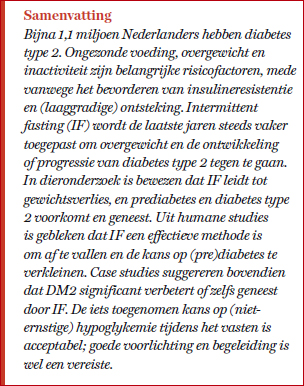Intermittent fasting tegen diabetes type 2
12 Aug, 2019
Door: Selma Timmer

Een teveel aan lichaamsvet is de belangrijkste risicofactor voor DM2. Niet alleen bij overgewicht of obesitas, ook bij een normaal gewicht maar een te hoog percentage vetweefsel, met name rond de taille, is de kans op insulineresistentie en diabetes type 2 (DM2) verhoogd.1 In de literatuur gebruikt men de term MONW: Metabolically Obese, Normal Weight. Intermittent fasting verkleint het risico van DM2.
IF is een effectieve afvalmethode. De kans op DM2, geassocieerd met te veel lichaamsvet, neemt gestaag toe bij iedere verhoging van de queteletindex (vanaf 23 kg/m2), de taille-omvang of de huidplooidikte. Aangezien het relatieve risico op DM2 bij een queteletindex vanaf 23 kg/m2 hoger is (2,67) dan bij een index tot 23, is een waarde tussen 18,5 tot 23 aan te bevelen, terwijl vanaf 25 pas sprake is van overgewicht.1 Het is altijd zinvol af te vallen, meer te bewegen en gezond te eten. Bij mensen met obesitas en prediabetes leidde afname van het lichaamsgewicht met 7%, in combinatie met regelmatige lichaamsbeweging, tot afname van de kans op DM2 met 58%.2 In een review van 27 humane studies aan proefpersonen met overgewicht of obesitas, al dan niet met DM2, blijken verschillende vormen van IF effectief bij het afvallen. Zo kan men iedere dag 12-20 uur vasten (TRF, Time Restricted Feeding), of om de dag ‘vasten’: ADF, Alternate Day Fasting, met een calorie-inname van 500 kCal of 25% van de normale calorie-inname rond het middaguur. Ook is het mogelijk iedere week één (1/6 schema) of twee (2/5 schema) dagen te ‘vasten’ (25% van de normale calorie-inname).2
Afvallen met TRF gaat langzamer dan met andere vormen van IF; afvallen via ADF gaat het snelst. IF volgens de 1/6 of 2/5 methode leidt tot gemiddeld 0,25 kilo gewichtsverlies per week, ADF tot 0,75 kilo per week.3 Belangrijk voordeel van IF bij overgewicht en obesitas is dat significant gewichtsverlies gepaard gaat met behoud van de vetvrije massa.2 Ook leidt IF niet tot daling van de ruststofwisseling. Dat is gunstig, omdat daling van de ruststofwisseling is geassocieerd met opnieuw aankomen na afloop van een dieet. Bij MONW-personen is afvallen niet per se nodig en leidt IF met name tot afname van de vetmassa, toename van de vetvrije massa en een betere stofwisseling en insulinegevoeligheid.
Lees het gehele artikel vanaf pagina 18 in OrthoFyto 4/19. Wilt u het hele artikel als PDF bestand ontvangen? Bestel het dan hier voor € 3,50 Bronvermelding:- Ley SH et al. Chapter 13: Risk factors for type 2 diabetes. In: Diabetes in America, 3rd edition. National Institutes of Health, NIH pub no. 17-1468, 2018.
- Zubrzychki A et al. The role of low-calorie diets and intermittent fasting in the treatment of obesity and type-2 diabetes. J Physiol Pharmacol. 2018;69(5).
- Barnosky AR et al. Intermittent fasting vs daily calorie restriction for type 2 diabetes prevention: a review of human findings. Transl Res. 2014;164:302-311.
- Harvie M et al. The effect of intermittent energy and carbohydrate restriction v. daily energy restriction on weight loss and metabolic disease risk markers in overweight women. Br J Nutr. 2013;110:1534-1547.
- Alhamdan BA et al. Alternate-day versus daily energy restriction diets: which is more effective for weight loss? A systematic review and meta-analysis. Obes Sci Pract. 2016;2:293-302.
- Sutton EF et al. Early time-restricted feeding improves insulin sensitivity, blood pressure, and oxidative stress even without weight loss in men with prediabetes. Cell Metab. 2018;27(6):1212-1221.e3.
- Horne BD et al. Relation of routine, periodic fasting to risk of diabetes mellitus, and coronary artery disease in patients undergoing coronary angiography. Am J Cardiol. 2012;109:1558-1562.
- Furmli S et al. Therapeutic use of intermittent fasting for people with type 2 diabetes as an alternative to insulin. BMJ Case Rep. 2018 Oct 9;2018.
- Carter S et al. Effect of intermittent compared with continuous energy restricted diet on glycemic control in patients with type 2 diabetes: a randomized noninferiority trial. JAMA Netw Open. 2018;1(3):e180756.
- Grajower MM et al. Clinical management of intermittent fasting in patients with diabetes mellitus. Nutrients. 2019;11:873.
- Corley BT et al. Intermittent fasting in type 2 diabetes mellitus and the risk of hypoglycaemia: a randomized controlled trial. Diabet Med. 2018;35(5):588-594.
- Anton SD et al. Flipping the metabolic switch: understanding and applying the health benefits of fasting. Obesity (Silver Spring). 2018;26(2):254-268.
- Mattson MP et al. Impact of intermittent fasting on health and disease processes. Ageing Res Rev. 2017;39:46-58.
- Rothman SM et al. Brain-derived neurotrophic factor as a regulator of systemic and brain energy metabolism and cardiovascular health. Ann N Y Acad Sci. 2012;1264:49-63.
- Stockman MC et al. Intermittent fasting: is the wait worth the weight? Curr Obes Rep. 2018;7(2):172-185.
